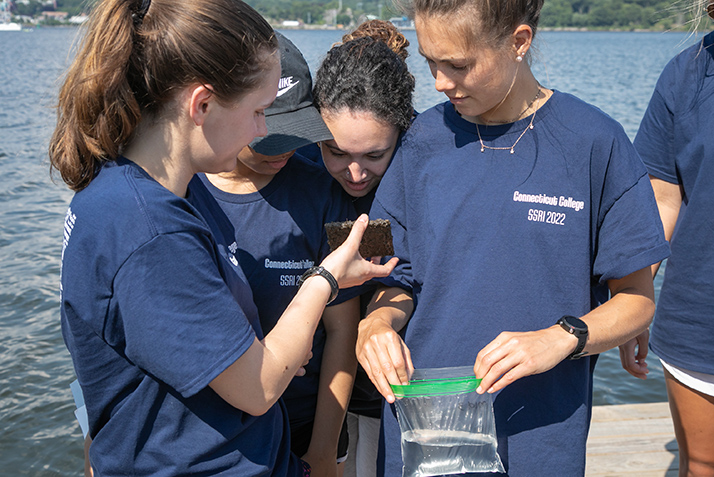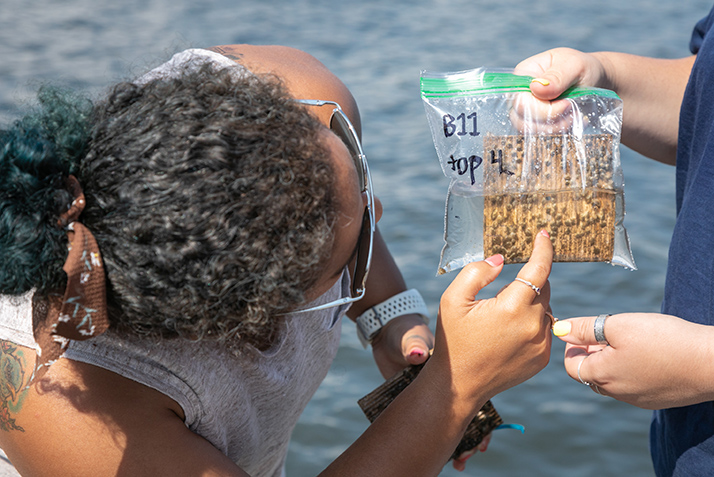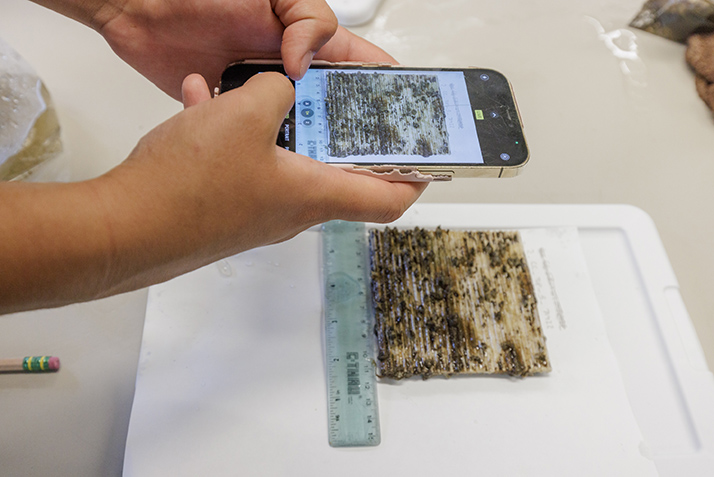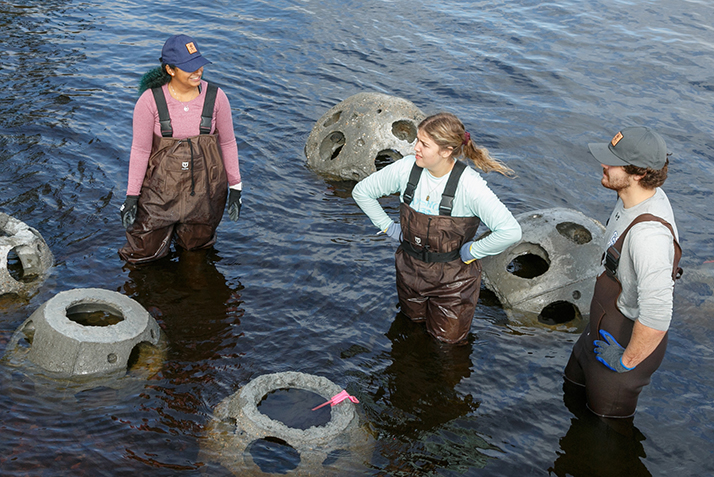
Ecology on the Thames
Two Conn professors create the first 3D printed, biodegradable aquatic habitats in a quest to save the world’s coral reefs.
With the future of marine habitats and coral reefs around the world at stake, excitement is palpable on the rowing docks along the banks of the Thames River at the edge of Conn’s campus.
Two student researchers have just fished a PVC pipe tree out of the water. It’s adorned with 12 small, 3D printed biodegradable plates, each teeming with life.
Maria Rosa, the George & Carol Milne Assistant Professor of Biology at Conn, lays on the dock to get a closer look, her voice rising as she describes what she is seeing to her colleague, Associate Professor of Biology Taegan McMahon, and the half dozen student researchers gathered around.
“There are so many barnacles! Scallops! Look at that, that’s a sea snail … There’s the tiniest crab you ever saw,” says Rosa, who joined Connecticut College in 2018 and was named an emerging scholar by Diverse Issues in Higher Education in 2020.
The mood is jovial on this summer evening as the small group readies each sample for analysis. The team knows the research they are conducting may prove integral to saving marine habitats around the world.
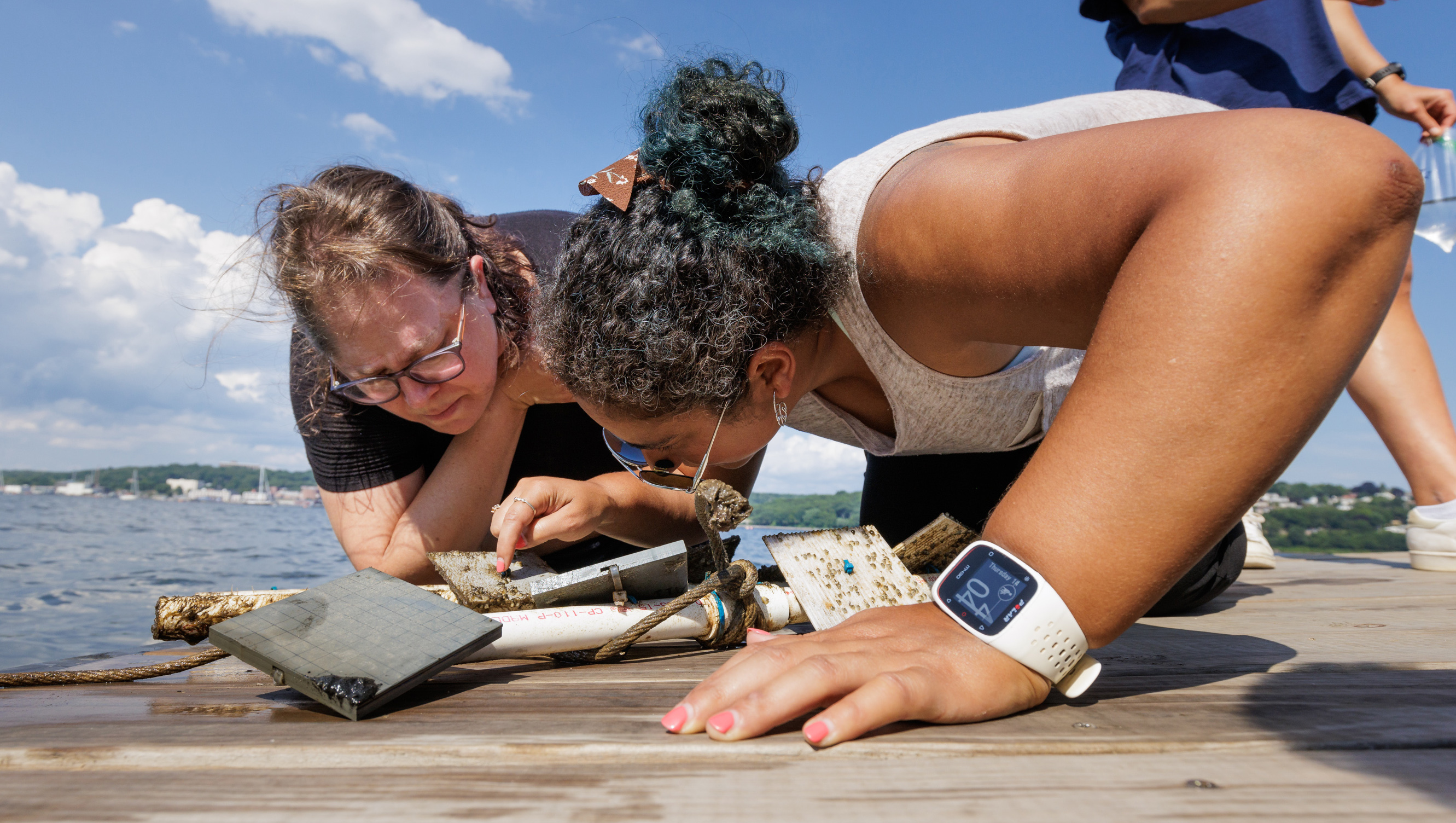
Rosa specializes in marine biology and ecology and develops new techniques to restore natural ecosystems and protect vulnerable shorelines. Recently, she’s been working on coral reef restoration in Colombia and the British Virgin Islands.
“Reefs are essential to marine ecosystems, but humans have destroyed so much natural habitat that there is nowhere for small marine invertebrates like coral and shellfish to settle,” she says.
Essentially, if the organisms have nothing to stick to, they can’t grow. Scientists have been working to create artificial habitats, but so far, the materials are too expensive, create environmental problems of their own, or just don’t work well.
“Those little guys love plastic—throw a buoy into the ocean and it will soon be filled with barnacles—but we don’t want to introduce more non-biodegradable plastic,” Rosa explains. “They don’t seem to like wood. We’ve had some success with 3D printed ceramic panels, but they cost anywhere from $50 to $200 each to make and are expensive to ship because they’re so heavy, so it becomes too costly to use on a large scale.”
McMahon, who joined Conn’s faculty in 2020, is a conservation disease ecologist who generally focuses more on saving frogs than coral reefs. She’s been developing a vaccine for a fungus that is killing more than 500 amphibian species around the world. But she also works with 3D printers, so when Rosa mentioned she was looking into the possibility of 3D printing biodegradable artificial aquatic habitats, McMahon suggested they try four different affordable materials.
To cover the cost of supplies and 3D printing, Rosa and McMahon secured a $2,000 “Research Matters” grant from the Office of the Dean of the Faculty. Three of the biodegradable materials—one soy-based, one corn-based and one made from wood pulp—printed well, and a $30 spool of material would yield approximately 30 of the 4x4-inch ridged panels. The fourth material, made from old algae removed from aquariums and other aquatic spaces, proved not to be uniform enough to work in the printer, although McMahon jokes that she hasn’t given up. “It’s such a cool material, so I’m still trying to figure it out,” she says.
After McMahon’s three student researchers confirmed the material would not harm the aquatic organisms they hoped would settle on the plates, there was one thing left to do: Put them in the water to see if anything stuck.
“It worked beyond our wildest dreams,” says Rosa of the preliminary experiment in the Thames. “Within just one week, we had a whole variety of species settled on the plates. Even the wood pulp, which surprised me, since they don’t generally like wood.”
The team tested the plates in the Thames River for six weeks over the summer, and Rosa is now deploying pilot studies at other locations, including the Long Island Sound, the British Virgin Islands and Oceanarios Marine Park in Colombia. If those experiments go as well, the inexpensive 3D printed biodegradable plates could become the new standard for artificial aquatic habitats across the world.
That prospect is thrilling to the seven Conn students who spent the summer conducting the research alongside their professors.
“It’s very exciting and rewarding to be aiding in research that could have large-scale positive impacts on the environment,” said Edin Sisson ’23, a botany major, English minor and scholar in the Goodwin-Niering Center for the Environment from Sidney, Maine. “The whole process has given me tremendous hope for a more sustainable future for the marine world.”
The student research was primarily funded through Conn’s Summer Science Research Institute, an eight-week program that provides students with housing and a stipend. As part of the program, each student leads their own project in the lab while contributing to the professor’s research.
“The students are exposed to all aspects of the scientific process. They gain experience in ecological monitoring and methods development, they participate in data analysis and manuscript preparation, they co-author journal articles and they get experience conducting research as a part of a team but also as a leader,” McMahon says.
It’s very exciting and rewarding to be aiding in research that could have large-scale positive impacts on the environment.
The hands-on experience has inspired Mitchell Lockwood ’23, a biology major and psychology minor from Winchester, Mass.
“Working with both of these professors has been amazing,” he says. “For a young researcher, knowing that your work will one day help so many different areas of the world really lights that fire under you to keep working harder.”
The collaboration between the two professors also gives students a look at how scientists with different areas of expertise can work together to solve complex global problems.
Grace Robinson ’24, a biology and government double major and Goodwin-Niering Center for the Environment scholar from Northbridge, Mass., was excited to work with Rosa, whose research aligns closely with her own interest in manatee preservation. Getting to work with McMahon, too, proved fascinating, she says. “I learned so much about different facets of biological research and how different methods can work together.”
Rosa and McMahon plan to use the results of this summer’s preliminary research to apply for larger grants to expand the pilot program and include more students. At the same time, they are continuing their own separate research. McMahon is the recipient of a National Institutes of Health grant to investigate non-amphibian hosts that may spread the deadly Batrachochytrium dendrobatidis pathogenic fungus, as well as a National Science Foundation grant for vaccine development to help protect vulnerable frog populations.
Rosa has been awarded more than $100,000 in new grants, including from the Ingalls Foundation, Schmidt Family Foundation and Bennack-Poland Foundation, to continue her work with reef balls. The hemispheric concrete artificial reefs are being used around the world—and on Conn’s riverfront—to restore natural ecosystems and protect vulnerable shorelines.
“It’s amazing to see how quickly the environment is transforming,” Rosa says. “We have a restored waterfront and a great habitat for research, and it’s right here on our campus.”

